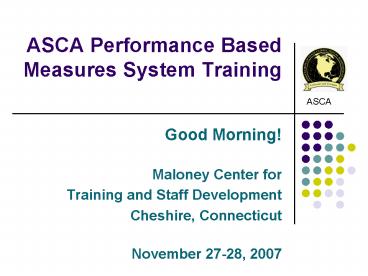ASCA Performance Based Measures System Training PowerPoint PPT Presentation
1 / 17
Title: ASCA Performance Based Measures System Training
1
ASCA Performance Based Measures System Training
- Good Morning!
- Maloney Center for
- Training and Staff Development
- Cheshire, Connecticut
- November 27-28, 2007
2
The Training Introductions
- Who you are.
- What you do in your jurisdictions.
- Your expectations.
3
The Training Introductions
- Connecticut
- Jody Barry, Research Analyst
- Mary Lansing, Associate Research Analyst
4
The Training Introductions
- District of Columbia
- Joseph Peters, Operations Research Analyst
5
The Training Introductions
- New York City
- William Beiersdorfer, Captain
- Robert Ortega, Correction Officer (TEAMS Unit)
6
The Training Introductions
- Rhode Island
- Michelle Lanciaux, Associate Director of
Management Information Systems - Erin Boyar, Associate Director, Planning and
Research Unit
7
The Training Introductions
- Vermont
- Leane Garland, Quality Management Director
8
The Training Introductions
- Who we are and why we are here.
- George Camp
- Marla Clayton
- Patricia Hardyman
- Dave Marcial
9
The Training
- Overview of Agenda
- and
- Housekeeping Items
10
PBMS Overview Definition
What is ASCAs Performance Based Measures
System? The Association of State Correctional
Administrators (ASCA) has developed uniform
standards and measures of correctional
performance so that review and research of its
performance data across jurisdictions can be
analyzed with a high degree of certainty that
numbers and rates are calculated the same way by
all participants.
11
PBMS Overview Benefits
- What does such a System do for Corrections?
- Promotes performance accountability and
decision-making capability in jurisdictions and
in the profession nationwide - Allows administrators to define the standards
of performance for their profession - Allows access to performance data from sister
agencies.
12
PBMS Overview Benefits
- What does this System do for Corrections?
- Promotes fair and healthy comparisons with
sister jurisdictions - Allows for trend studies for an agency and
among agencies and - Promotes accurate national reports of
correctional performance.
13
PBMS Overview History
- Began with an ASCA Committee in the 90s that was
concerned about how jurisdictions were being
judged concerning performance and being compared
unfairly with sister jurisdictions.
14
PBMS Overview History Development
- Phase I. Achieved federal funding in 2001 to
develop standards, measures, key indicators and
counting rules. - Phase II. Funded to continue development, to
launch a website for data collection and to run a
pilot in six states.
15
PBMS Overview History Development
- Phase III. Funded to refine web application,
develop more standards and measures and
indicators and counting rules, and add 24
jurisdictions to the participant pool.
16
PBMS Overview History Development
- Phase IV. Funded to enhance the PBMS software, to
expand the scope and number of PBMS standards,
measures, and key indicators, to provide
technical support to users in all jurisdictions,
and to add 24 jurisdictions to the participant
pool.
17
PBMS Overview Development Process
- Select Standards and Measures
- Develop Key Indicators for Each Measure
- Gain consensus on Definitions and Counting Rules
- Add new fields to the data application
- Train new participants
- Monitor performance
- Refine rules and procedures

